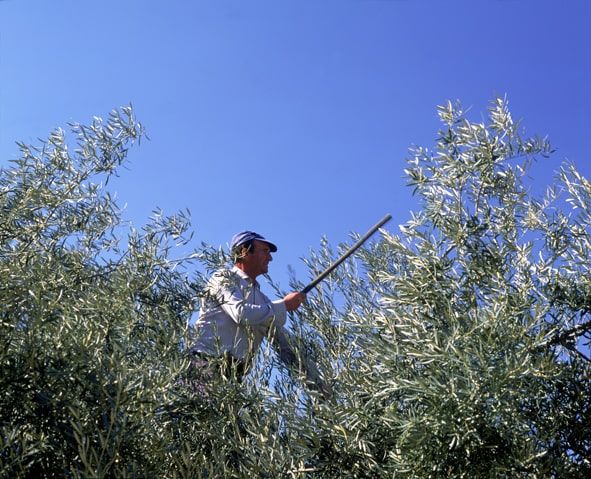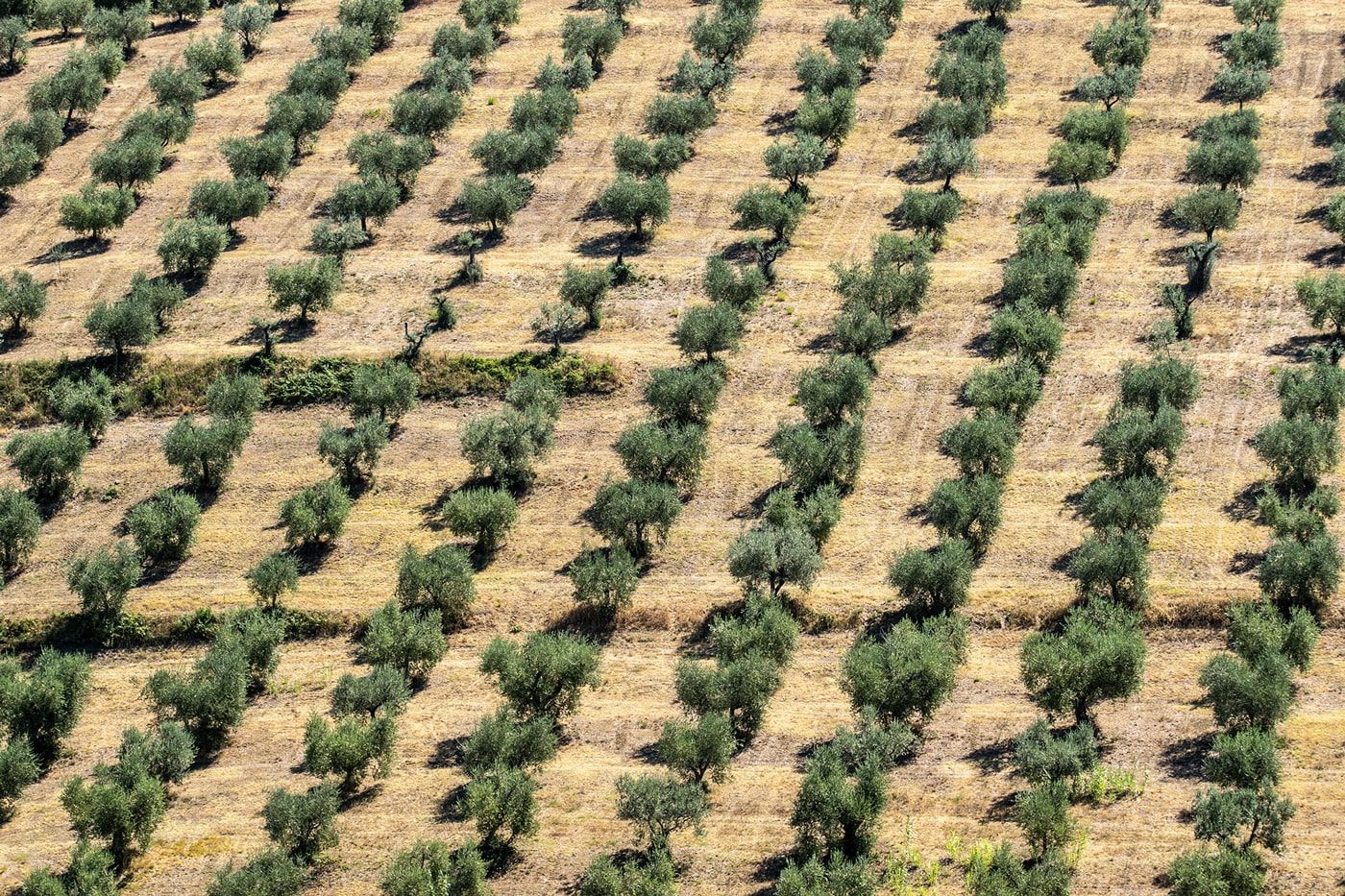Ancient to modern farming
Learn more how olive oil is made now and it's progression from ancient times.
Ancient Footsteps
Olive oil has been at the core of Mediterranean food and culture for thousands of years. Olive trees appeared in Eastern Mediterranean farming more than 6000 years ago with roots back to ancient Palestine, Crete and Egypt.
In ancient Greece, the olive tree was a subject of mythology and the olive branch became a symbol of peace, while at the same time olive oil became well-regarded for its apparent health and healing properties, for use in food as well as in skin-care, cosmetics and pharmaceuticals. Perhaps this is why olive oil has sometimes been called “liquid gold” and the “Elixir of the Gods”. It is believed that the olive tree was brought to the Iberian Peninsula by the Phoenicians and the Greeks, but it was subsequently the Romans who expanded the cultivation and production methods greatly. Olive oil from Hispania gained a reputation for superior quality throughout the Roman Empire. The influence of Arab peoples in Spain led to further improvements in olive oil production techniques, and interestingly the Spanish word for oil, aceite, stems from the Arabic al-zat, or olive juice.
Olive oil is the oldest edible oil and still one of the most important parts of the Mediterranean diet today. The olive tree history has a deep and amazing footprint throughout history in many countries. The origin of the olive tree is lost in time, coinciding and mingling with the expansion of the Mediterranean civilisations. Fossils of the olive trees have been found in Italy to Spain to North Africa
- The wild olive tree originated in Asia Minor where it was extremely abundant and grew in thick forests (6 millennia ago)
- Its cultivation developed in Syria and Palestine before spreading to islands of Cyprus and Crete to Egypt
- In the 16th century BC, the Phoenicians started disseminating the olive throughout the Greek isles, later introducing it to the Greek mainland between the 14th and 12th centuries BC where its cultivation increased
- From the 6th century BC onwards, the olive spread throughout the Mediterranean countries reaching Tripoli, Tunis and the island of Sicily. From there, it moved to southern Italy.
- Oil production in the Eastern Mediterranean can be traced to archives of the ancient city-state Ebla (2600–2240 BC), which were located on the outskirts of the Syrian city Aleppo.
- Olive growing was introduced into Spain during the maritime domination of the Phoenicians (1050 BC) but did not develop to a noteworthy extent until the arrival of Scipio (212 BC) and Roman rule (45 BC).
- Olive growing was introduced into Spain during the maritime domination of the Phoenicians (1050 BC) but did not develop to a noteworthy extent until Roman rule (45 BC). .
- The Arabs brought their varieties with them to the south of Spain and influenced the spread of cultivation so much that the Spanish words for olive (aceituna), oil (aceite), and wild olive tree (acebuche) and the Portuguese words for olive (azeitona) and for olive oil (azeite), have Arabic roots.
- With the discovery of America (1492) olive farming spread beyond its Mediterranean confines.- by 1560 olive groves were being cultivated in Mexico, then later Peru, California, Chile & Argentina
- The International Olive Council, the world’s only international intergovernmental organisation in the field of olive oil and table olives, was set up in Madrid in 1959 under the auspices of the United Nations
- Invention of the centrifuge: 1864 and it was a “dairy centrifuge”

Farming Today
Olive oil is made from the juice of the olive fruit. Olives are harvested around October in the Northern Hemisphere and around April and May in the Southern Hemisphere.
Approximately 95% of the olive oil supply to the world still comes from the Mediterranean, and the biggest producer is Spain followed by Italy then Greece. Different regions, fruit maturity and olive plant varieties produce different flavour profiles, similarly to wine.
The olive trees are known for their hardiness, longevity and attractive appearance. They also have a long life spanand tolerate all sorts of terrain that other species could not, as well as being fire- and drought-resistant. You might see olive trees on slopes, arid areas and environments that vary with water supply.
As with any fruit crop, proper farming, fertilisation, pruning, pest and disease control and irrigation all contribute towards the quality of the olives and therefore the oil.
The production of olive oil requires care. Olive trees begin to bear fruit after around five years and can continue to bear fruit for over 100 years. Olives are green at first and turn dark in colour as they ripen in the spring months, ready for harvesting by hand or machine in winter. Ripeness has a large influence on taste and generally the later in the season the olives are picked, the sweeter the olive oil will be, while oil from early harvest fruit be more powerful and bitter.
Old groves were planted in a “low-density” manner, meaning the trees are spaced well and given the best chance to thrive. These are often harvested by traditional means with manual shakers and hand-picked. Newer olive groves are often “high density” or even “super-high density”, which means the trees are planted very closely together and designed for the harvesting machinery.

Traditional Farming Methods
- Olive trees can live to more than 100 years old. In fact, there’ said to be a tree in the Greek Island of Crete that’s more than 3,000 years old!
- Plant densities in traditionally farmed areas are usually 100 olive trees to a hectare
- Careful hand-picking or gently knocking the olives from the tree is the oldest and least harmful harvesting method for both the tree and olives. The olives fall into nets on the ground for collection and they must not hit the ground as to not be affected by water or dirt.
- Older trees have their roots deeper in the earth and therefore less susceptible to disease and drought
- Lower density groves means that trees get adequate sunlight which is essential to the plant’s ability to slower and produce fruit.
Reference: http://sites.psu.edu/nzk5100/2014/02/27/olives/

Modern Farming Methods
- Modern harvesting methods such as shakers and straddle harvesters (pictured) have been developed to make the picking rate much faster, and has been based on systems used for other larger fruit
- Straddle harvesters are designed for large operations with high density groves and high levels of production
- Mechanicised methods of harvesting often shake the tree so rigorously that the branches, leaves and even the trunk can be damaged
- The high density planting of mechanically farmed areas is usually more than 300 trees per hectare. New groves are designed for maximum advantage of machinery
- Super high-density groves have only proven to work with three varieties of olive: Arbequina,Arbosana and Koroneiki. This is because of their relatively small size and height, as this structure of planting restricts how big the trees can be. Reference: http://www.maqtec.com/continuous-mechanical-harvesting-in-modern-australian-olive-growing-systems/